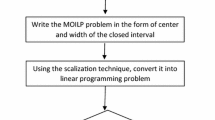Abstract
Linear programming (LP) is one of the most widely used methods in the area of optimization. Dealing with the formulation of LP problems, the parameters of objective function and constraints should be assigned by experts. In most cases, precise data have been used, but in most of the real-life situations, these parameters are imprecise and ambiguous. In order to deal with the problem of ambiguity and imprecision, fuzzy numbers can be appropriate. By replacing precise numbers with fuzzy numbers, LP problems change to fuzzy linear programming (FLP) problems. So FLPs can be considered as a broader category in comparison to LPs. Considering the above-mentioned points, FLP problems play an important rule in operational researches hence there is a need to investigate these problems. In this paper, a new method for solving the FLP problems is presented in which the coefficients of the objective function and the values of the right-hand side are represented by fuzzy numbers, while the elements of the coefficient matrix are represented by real numbers. To this end, we develop the Karush–Kuhn–Tucker (KKT) optimality conditions for FLP problems. Then, every FLP problem is converted to a fuzzy linear complementary problem (FLCP) by considering KKT conditions. In order to solve the FLCP problems, ranking functions and Lemke’s algorithm are used. Consequently, the solution to primal and dual problems of FLP is obtained. In addition to simplicity in calculations and feasibility, this method solves the primal and dual problems of FLP simultaneously. In order to illustrate the proposed method, some numerical examples are considered.
Similar content being viewed by others
References
Allahviranloo, T., Shamsolkotabi, K.H., Kiani, N.A., Alizadeh, L.: Fuzzy integer linear programming problems. Int. J. Contemp. Math. Sci. 2, 167–181 (2007)
Buckley, J.J., Feuring, T.: Evolutionary algorithm solution to fuzzy problems: Fuzzy linear programming. Fuzzy Sets Syst. 109, 35–53 (2000)
Bazaraa, M.S., Jarvis, J.J., Sherali, H.D.: Linear programming and network flows, pp. 221–223. Wiley, New York (1977)
Bellman, R.E., Zadeh, L.A.: Decision making in a fuzzy environment. Manag. Sci. 17, 141–164 (1970)
Campos, L., Verdegay, J.L.: Linear programming problems and ranking of fuzzy numbers. Fuzzy Sets Syst. 32, 1–11 (1989)
Dehghan, M., Hashemi, B.: Solution of the fully fuzzy linear systems using the decomposition procedure. Appl. Math. Comput. 182–2, 1568–1580 (2007)
Dubois, D., Prade, H.: Operations on fuzzy numbers. Int. J. Syst. Sci. 9, 613–626 (1978)
Dubois, D., Prade, H.: Fuzzy sets and system; theory and applications. Academic Press, New York (1980)
Ebrahimnejad, A., Nasseri, S.H.: Using complementary slackness property to solve linear programming with fuzzy parameters. Fuzzy Inf. Eng. 1, 233–245 (2009)
Ebrahimnejad, A., Nasseri, S.H., Lotfi, F.H., Soltanifar, M.: A primal-dual method for linear programming problems with fuzzy variables. Eur. J. Ind. Eng. 4, 189–209 (2010)
Ebrahimnejad, A., Tavana, M.: A novel method for solving linear programming problems with symmetric trapezoidal fuzzy numbers. Appl. Math. Model. 38, 4388–4395 (2014)
Ganesan, K., Veeramani, P.: Fuzzy linear programs with trapezoidal fuzzy numbers. Ann. Oper. Res. 143, 305–315 (2006)
Hashemi, S.M., Modarres, M., Nasrabadi, E., Nasrabadi, M.M.: Fully fuzzified linear programming, solution and duality. J. Intell. Fuzzy Syst. 17, 253–261 (2006)
Lotfi, F.H., Allahviranloo, T., Jondabeh, M.A., Alizadeh, L.: Solving a full fuzzy linear programming using lexicography method and fuzzy approximate solution. Appl. Math. Model. 33, 3151–3156 (2009)
Jimenez, M., Arenas, M., Bilbao, A., Rodrguez, M.V.: Linear programming with fuzzy parameters: An interactive method resolution. Eur. J. Oper. Res. 177, 1599–1609 (2007)
Lemke, C.E.: On complementary pivot theory. In: Dantzig, G.B., Veinott, A.F. (eds.) Mathematics of the Decision Sciences. American Mathematical Society, Providence (1968)
Liu, X.: Measuring the satisfaction of constraints in fuzzy linear programming. Fuzzy Sets Syst. 122, 263–275 (2001)
Mahdavi-Amiri, N., Nasseri, S.H.: Duality in fuzzy number linear programming by use of a certain linear ranking function. Appl. Math. Compos. 180, 206–216 (2006)
Mahdavi-Amiri, N., Nasseri, S.H.: Duality results and a dual simplex method for linear programming problems with trapezoidal fuzzy variables. Fuzzy Sets Syst. 158, 1961–1978 (2007)
Mahdavi-Amiri, N., Nasseri, S.H., Yazdani, A.: Fuzzy primal simplex algorithms for solving fuzzy linear programming problems. Iran. J. Oper. Res. 1, 68–84 (2009)
Maleki, H.R., Tata, M., Mashinchi, M.: Linear programming with fuzzy variables. Fuzzy Sets Syst. 109, 21–33 (2000)
Maleki, H.R.: Ranking functions and their applications to fuzzy linear programming. Far East J. Math. Sci. 4, 283–301 (2002)
Nasseri, S.H.: A new method for solving fuzzy linear programming by solving linear programming. Appl. Math. Sciences 2, 2473–2480 (2008)
Nehi, H.M., Maleki, H.R., Mashinchi, M.: Solving fuzzy number linear programming problem by lexicographic ranking function. Ital. J. Pure Appl. Math. 15, 9–20 (2004)
Ozelkan, E., Duckstein, L.: Primal fuzzy counterparts of scheduling rules. Eur. J. Oper. Res. 113, 593–609 (1999)
Ramik, J.: Duality in fuzzy linear programming: Some new concepts and results. Fuzzy Optim. Decis. Mak. 4, 25–39 (2005)
Rommelfanger, H.: A general concept for solving linear multicriteria programming problems with crisp, fuzzy or stochastic values. Fuzzy Sets Syst. 158, 1892–1904 (2007)
Tanaka, H., Ichihashi, H., Asadi, K.: A formulation of fuzzy linear programming problem based on comparison of fuzzy numbers. Control Cybern. 13, 185–194 (1984)
Yager, R.R.: A procedure for ordering fuzzy subsets of the unit interval. Inf. Sci. 24, 143–161 (1981)
Zadeh, L.A.: Fuzzy Sets. Inf. Control 8, 338–353 (1965)
Zhang, G., Wu, Y.H., Remias, M., Lu, J.: Formulation of fuzzy linear programming problems as four-objective constrained optimization problems. Appl. Math. Comput. 139, 383–399 (2003)
Zimmerman, H.J.: Fuzzy programming and linear programming with several objective functions. Fuzzy Sets Syst. 1, 45–55 (1978)
Zimmerman, H.J.: Fuzzy Set Theory and its Applications. Kluwer Academic Publishers, Boston (2001)
Author information
Authors and Affiliations
Corresponding author
Rights and permissions
About this article
Cite this article
Mottaghi, A., Ezzati, R. & Khorram, E. A New Method For Solving Fuzzy Linear Programming Problems Based on The Fuzzy Linear Complementary Problem (FLCP). Int. J. Fuzzy Syst. 17, 236–245 (2015). https://doi.org/10.1007/s40815-015-0016-5
Received:
Revised:
Accepted:
Published:
Issue Date:
DOI: https://doi.org/10.1007/s40815-015-0016-5




